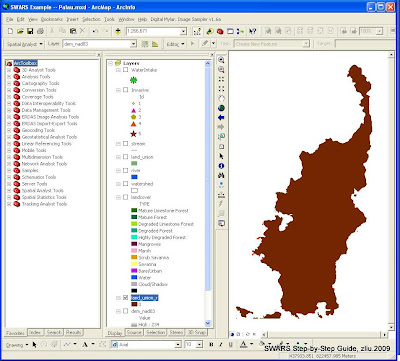Off we go now!
I start by bringing in all the 7 input layers (provided in the example data pacaket). The seven layers are:
1. WaterIntake (Point)
2. Invasive (Point)
3. Stream (Line)
4. River (Line)
5. Watershed (Polygon)
6. LandCover (Polygon)
7. DEM (Grid)

We have two existing polygon layers here, the Watershed layer and the LandCover layer. When you zoom in to the coast areas, you will see a lot of these "gaps" as pointed out in this image:

Using either of these two polygon layers as the analysis mask, you will end up losing some data. A compromise? I will use the Union tool to merge these two polygon layers together.

(Shown on the image above)
I know which tool I will use already. So, I just go to Arctoolbox, click the <Index>

Next, open the attribute table of this newly created Land_Union layer. Create a new attribute field and name it "LandValue" using Short Integer type. And leave the value as t

I will then use the <Zoom>
Now, open the Spatial Analyst Option dialog again to set the analysis environment. Click on <Spatial Analyst>

* set my Working Directory to where I want to put all the output layers, and
* use Land_Union as the Analysis Mask.
(*** the data frame's coordinate system is defined by the first data layer you brought into the frame!!!)
In
* set the Analysis Extent to "Same as Display" (choose from the drop-down list), then
* set the Snap Extent to the DEM layer (dem_nad83).
Finally, under
* set the Analysis Cell Size to "Same as Layer "dem_nad83".
With the Analysis Environment set, we are ready to push forward!!
Click <Spatial Analyst>
The Features to Raster dialog will now open. If you highlighted the Land_Union layer first, it should be selected as the Input Features already. If you didn't, no worries either. Just select it use the drop-down list.
Choose "LandValue" as the Field from the list.
Output Cell Size should already be 10.
In the last option, I will name the output raster as Land_Union_R (with the R for "Raster"). Hit OK!
When it's done, we now have our "Perfect Boundary/Background" which is already defined to the most efficient spatial extent (try use the zoom to layer tool and see where it goes), with the right project and cell size, all thanks to the previous setting of the Analysis Environment!!




No comments:
Post a Comment